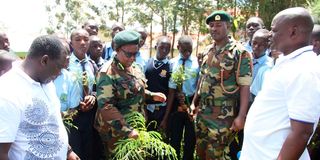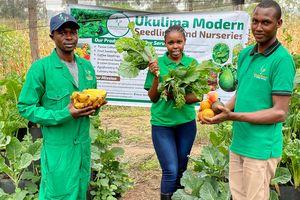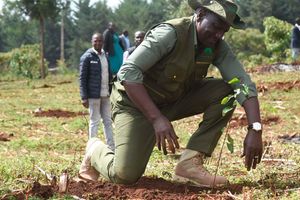KICD integrates tree planting into the education system

Students at Orero Boys High during a tree planting exercise at the school on March 26, 2025.
What you need to know:
- The programme is part of the government’s efforts of planting over 15 billion trees across the country by 2032.
The Kenya Institute of Curriculum Development (KICD) has introduced a programme in the education system where it engages students in tree planting as a means of conserving the environment.
The programme includes training students on planting, adopting and nurturing trees as part of efforts to enhance the implementation of the Competency-Based Curriculum (CBC).

The Kenya Forest Service officials led by Homa Bay County Forest Conservator Sharon Cheluget (in glasses) plant a tree at Orero Boys High school in Rangwe, Homa Bay County during the launch of a programme by the Kenya Institute of Curriculum Development (Kthat encourages students to plant trees.
It will enable learners to develop problem solving skills, in this case addressing the climate change crisis, according to KICD Director Charles Ong’ondo.
Prof Ong’ondo said the programme is part of the government’s efforts of planting over 15 billion trees across the country by 2032, adding that learners will spearhead the exercise and help the government in achieving its goal.
Noting that KICD was given a target of planting at least 250,000 tree seedlings, Prof Ong’ondo said: “We have exceeded our target. We have so far planted 800,000 seedlings.”
He added that KICD has set a target of planting at least 100,000 seedlings during the ongoing rainy season.
The agency has since deployed officials to different areas across the country to supervise the process and ensure it is successful.
Prof Ong’ondo noted that the agency has set targets for different counties.
In Homa Bay, for example, KICD plans to plant at least 25,000 seedlings.
“We have selected 25 schools in Homa Bay and each will plant 1,000 seedlings. We tell learners about the benefits of planting trees at school and in their homes,” Prof Ong’ondo said.
The programme encompasses training students on planting, adopting and nurturing trees. Each learner in the selected schools is tasked with the responsibility of nurturing a tree seedling or several seedlings at the same time.
The adoption enables individual students to inculcate the culture of planting and nurturing trees.
In CBC, Prof Ong’ondo explained, learners should be equipped with knowledge on how to use their skills in solving local problems.
“One of the pillars of CBC is when learners are able to solve pertinent and contemporary problems.”
The KICD boss also noted that environmental degradation and climate change pose significant challenges to the country, adding that it has become difficult to predict weather partners unlike before when people would know when it would rain and at what intensity.
He explained that climate change affects agricultural productivity, which in turn affects the country’s economy.
“We must therefore restore trees to combat environmental degradation and climate change.”
Homa Bay County Forest Conservator Sharon Cheluget said schools taking part in the exercise will get technical support from the Kenya Forest Service (KFS).
According to Ms Cheluget, Homa Bay has one of the lowest forest and tree cover at 3.4 per cent and 10.8 per cent respectively.
The recommended lowest forest cover should be 10 per cent while tree cover should be at least 30 per cent.
“We have identified schools to work with so that we can plant trees in their fields. We will also have woodlots within the institutions,” said Ms Cheluget.
She noted that deforestation, particularly for charcoal and firewood, remains one of the biggest challenges affecting forest cover in Homa Bay.
“Youths should be trained on environmental conservation so that we can achieve the country’s target of planning 15 billion trees by 2032.”
County Education Director Eunice Khamba said other schools have also been asked to join the campaign.
“The county is generally hot and teachers and learners are struggling to remain in class throughout the day. Classes can be held under trees during hot days but this can only be possible if there are trees in schools.”
At Orero Boys High School, some learners said they are ready to nurture trees.
Lenox Paul, a Form Two student, said he has learned the benefits of tree planting and will use the knowledge to influence his family to plant trees at home.
georgeodiwuor04@gmail.com


